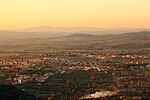Roman Catholic Diocese of Massa Marittima-Piombino
Accuracy disputes from January 2020All accuracy disputesDioceses established in the 5th centuryMassa MarittimaRoman Catholic dioceses in Tuscany

The Diocese of Massa Marittima-Piombino (Latin: Dioecesis Massana-Plumbinensis) is a Latin Church diocese of the Catholic Church in Tuscany, central Italy. It was known as Diocese of Massa Marittima before 1978. Up until 1458, it was a suffragan of the archdiocese of Pisa; since 1458, it has been a suffragan of the Archdiocese of Siena. The territory of the diocese includes the islands of Elba and Pianosa, and (up to 1817) Capraia.
Excerpt from the Wikipedia article Roman Catholic Diocese of Massa Marittima-Piombino (License: CC BY-SA 3.0, Authors, Images).Roman Catholic Diocese of Massa Marittima-Piombino
Piazza Giuseppe Garibaldi,
Geographical coordinates (GPS) Address Nearby Places Show on map
Geographical coordinates (GPS)
| Latitude | Longitude |
|---|---|
| N 43.0495 ° | E 10.8881 ° |
Address
Cattedrale di San Cerbone
Piazza Giuseppe Garibaldi
58024
Tuscany, Italy
Open on Google Maps










